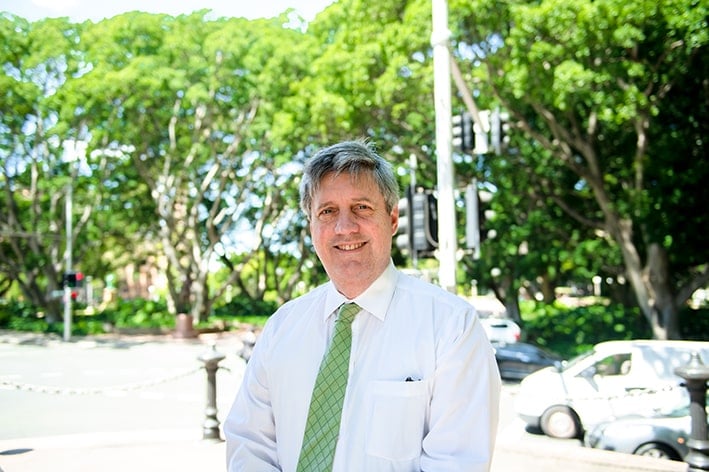
Talented historian Dr Damian Gleeson is inviting Catholics across the state to contribute to a new project he is undertaking on the Irish Catholic community in New South Wales after winning a prestigious fellowship from the State Library.
Dr Gleeson was awarded the $20,000 Australian Religious History Fellowship for 2021.
Dr Gleeson’s project, Irish-Australian Catholicism in the Penal Colony of New South Wales: Evidence from the Therry Collection will explore the Irish Catholic community in NSW between 1820 and 1860 through the lens of their experiences.
The Sydney historian said he was delighted and humbled to receive the fellowship and has already begun exploring around 70 boxes full of material, including letters that were written to the pioneering priest, Fr John Joseph Therry from the Catholic community at that time.
The Irish-born priest was, alongside fellow Irishman Fr Philip Conolly, the first official Catholic priests in Australia, when they arrived in Sydney in 1820.
While Fr Conolly only remained in Sydney for less than a year before being sent to Tasmania, Fr Therry spent more than 40 years as a priest here, including five in which he was effectively the only Catholic priest in NSW and often rode long distances on horseback to celebrate Mass and administer the sacraments to the faithful.
“There are letters in the collection from mothers, asking if Fr Therry could come and baptise their children in far-flung places”, explained Dr Gleeson in an interview with The Catholic Weekly.
“There are many letters from men on death-row in Sydney and Parramatta- not necessarily Catholics- people who were Protestants and Jewish- asking for Fr Therry to give them consolation before they were executed. So he did marvelous work in pastoral care to the people”.
Dr Gleeson said he is looking forward to chronicling the stories of faith and courage on the part of many Irish Catholics in the early days of the colony in a book at the conclusion of his research project.
Through the State Library fellowship, Dr Gleeson is hoping to capture not only the remarkable work of Fr Therry himself, but also the pivotal part played by many lay Irish Catholics who had either come to Sydney as convicts or voluntarily or were born in the colony with Irish parents.
“One example is the former Deputy Surveyor General, James Meehan, an Irish convict, who lobbied Governor Lachlan Macquarie to ensure that the site we have today was chosen for St Mary’s Cathedral when the authorities were planning on allocating only a small site to the Catholic Church in the Rocks”, Dr Gleeson explained.
“While the site we have today for the cathedral was seen back then as a very undesirable site, it is now the largest site of any church building in Sydney today and we’re blessed to have it”.
Dr Gleeson said the Irish Catholics at that time had to endure severe discrimination from the authorities and yet clung onto their faith under often the brutal conditions of a penal colony.
“People were executed for offences which today you’d probably receive a $200 fine for. If you stole a lamb or some cattle, that would usually lead to execution. So Sydney Town was a brutal place because you had, not just public floggings on a weekly basis, but executions as well”, he said.
In the decade leading up to Fr Therry and Fr Conolly’s arrival in Sydney, Dr Gleeson said there were many remarkable accounts of lay Catholics keeping the faith alive in the absence of public Masses.
Among them was the Irish-born stonemason, James Dempsey who led the Rosary and prayers from his home in Cumberland Street, while Dr Gleeson said the first official Mass was celebrated at the Pitt Street home of Irish-born publican, John Reddington.
Prior to the arrival of the first official chaplains, Dr Gleeson said there is some evidence to suggest that two Irish convict priests, Fr James Dixon and Fr James Harold had celebrated secret Masses in Sydney.
This was also the case for Irish-born Fr Jeremiah Flynn who although not a convict, was deported by Governor Macquarie in 1817 since he had not had approval from the authorities to minister in the colony. After one of his secret Masses, Fr Flynn had by accident or design, left the Blessed Sacrament at William Dempsey’s home and the best room of the house was in turn turned into a chapel with the faithful watching over the Blessed Sacrament until the arrival of the official priests in 1820.
Dr Gleeson said he is looking forward to chronicling the stories of faith and courage on the part of many Irish Catholics in the early days of the colony in a book at the conclusion of his research project.
“Lay Catholics played an incredibly important role in supporting Fr Therry and yet the involvement of the lay Catholics hasn’t really come into the historical literature much before and so I’m really hoping to give that appropriate emphasis in the book”, he added.
Dr Gleeson said he will explore the history of early Irish Catholic communities not only in inner Sydney, but in other areas including Windsor, Campbelltown and Liverpool.
